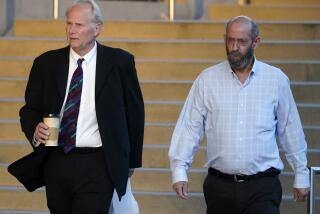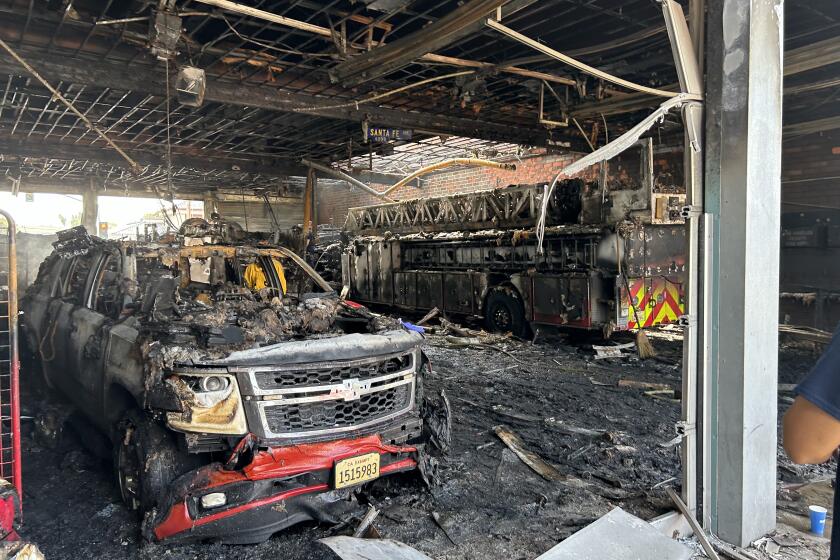Where there’s brush ...
Anthony Bowles and his wife, Judy, built a house on top of Kite Hill in Mount Washington in 1997 because they fell in love with the view from downtown Los Angeles to Catalina and Rancho Palos Verdes.
But on May 19, Bowles couldn’t see anything from his windows because of thick smoke from a nearby brush fire. He went outside to see flames raging toward his house.
“The fire was below the house in the canyon,” Bowles said, “but the wind was picking up a bit.”
As he turned on his sprinklers and called 911, he wondered whether he should evacuate.
“We didn’t know anything about fires,” Bowles said. Because helicopters were already racing to the scene to extinguish the blaze, he and his family, including a 2-week-old infant, were told they did not need to evacuate.
Every year during the May-to-December fire season, fire departments, brush-clearance inspectors and hillside homeowners throughout the Southland scramble to reduce the possibility of wildfires like the one that threatened the Bowles’ home. And this year’s near-record levels of rain have produced unusually high levels of brush and grass, which make it easier for fires to start and spread quickly. It’s not just outlying areas that are at risk. Over the Fourth of July weekend, firefighters in Los Angeles County battled 150 small blazes, and fire departments in the city of Los Angeles, Orange County and Ventura County are on high alert.
Capt. Carlos Calvillo, community liaison officer for the Los Angeles Fire Department, said he expects the number and intensity of the fires this year to be greater because the “flash fuels” are much taller. Flash fuels include indigenous field grasses, such as mustard grass and weeds. These plants, which usually grow to no more than 5 feet tall, are 6 to 8 feet tall this year.
“They’re dangerous because they dry out and burn extremely quickly, and it doesn’t take much to light them,” he said. Burning grass can ignite brush, which is heavier, and spread to trees.
Santa Clarita Fire Capt. Jerry Meehan attributed the daily grass fires that have been burning in nearby Antelope Valley to the high weeds. He and his department are bracing for a year with a very high risk of fire.
“We’ve had a lot of fires and the grass isn’t even that dry yet,” he said.
Southland fire departments focus their prevention efforts on brush in hilly areas where homeowners and businesses are required to clear brush and grass from within at least 100 feet of structures or adjoining properties. It is crucial that brush is cleared by the end of July, said Paul Terris, fire inspector for the Los Angeles Fire Department, “before the dry, hot Santa Ana winds start blowing in September, October and November.”
These winds can make even a small fire difficult to fight, Terris said, as the winds can blow embers up to several miles away, igniting other spot fires.
A June 29 grass fire that started in a lot adjacent to the Spectrum Health Club in Thousand Oaks burned grass right up to the club’s parking lot, said Adam Kinaan, the club’s general manager.
“We were lucky we had just cleared all the grass and brush around us,” Kinaan said, “so the flames there didn’t get that high.”
Although clearance within 100 feet of any structure became the California state minimum as of Jan. 1, each municipal fire department creates and monitors its own standards, based on the local terrain and wind conditions.
In Los Angeles, homeowners who live in the Fire Department’s designated “very high fire severity zone” -- a 158-square-mile area that includes Mount Washington, Laurel Canyon, Roscomare Valley and other areas throughout the Hollywood Hills and Santa Monica Mountains -- receive notices every spring requiring them to clear brush and grass within 200 feet of homes or buildings by early May.
Homeowners in this zone are required to cut their grass and weeds to 3 inches tall, trim brush by one-third of its height and trim trees so that the branches are at least 6 feet off the ground.
As a result of the strict guidelines, Terris said, “we haven’t lost a structure to a brush fire in over 10 years.”
Although most residents comply, Terris said the department still spends a lot of time issuing citations and eventually clearing brush for those who do not comply.
Some hillside residents find out the hard way how strict the regulations are. In addition to a $254 initial warning fine, Los Angeles homeowners who fail to comply will get the bill for brush clearance and another $314 tacked on to their property taxes for noncompliance.
Although Mount Washington resident Kevin King was vaguely aware when he moved in three years ago that he had to clear the brush, he didn’t realize he had to trim it back so severely.
“We got the notice from the city, and I went and tried to do it myself. I thought it was pretty clear,” King said. “Then we got another notice saying they would give us two weeks to really cut it down.”
After his own initial efforts fell short, he paid a brush-clearance company $300 to trim tree branches away from the house and shear bushes to a fraction of their size.
In areas where there are a high number of vacant lots, it can take several months before the city clears brush left by negligent property owners, a cause of concern among homeowners in neighborhoods like Mount Washington.
“No one seems to take care of these lots, and that’s where the fires have started,” Bowles said. From his house, Bowles can see the vacant lots where each of the three brush fires burned in May.
“I clear my yard, I’ve planted fire-retardant ground cover, but I have to worry about these other people who don’t,” he said.
Bowles also said that he installed outdoor sprinklers partly for fire prevention. The Fire Department, however, discourages homeowners from turning on their sprinklers during a full-scale blaze. Using the local water supply can deplete resources for firefighters.
Homeowner associations in Roscomare Valley -- which includes Bel-Air, the site of a disastrous 1961 blaze -- and Laurel Canyon report they have been stepping up their efforts to keep homeowners on their toes this year.
“At homeowner meetings, in mailings and in e-mails, we’re making sure everyone knows about the situation this year,” said Tom O’Rourke, vice president of the Laurel Canyon Homeowners Assn.
Homeowners in Bel-Air also have become more vigilant on their own, said Steve Twining, a Roscomare Valley resident who is also president of the Bel-Air Beverly Crest Neighborhood Council.
“If they see that someone has not cleared their brush, they don’t hesitate to call the brush authorities,” he said. “I hope that doesn’t sound like a police state.”
Terry Nunn, a Coldwell Banker Realtor who specializes in the Mount Washington area, says he makes an effort to inform potential home buyers of the risks and responsibilities of living near brush and grass fields, which can include higher premiums for homeowners insurance.
“There’s a great advantage to being in the hills,” he said. “You’re away from the city, you get privacy, you get great views, there’s less traffic, but you have to know how to be safe up there too.”
Jennifer Lisle can be reached at jenlisle1119@aol.com.
More to Read
Start your day right
Sign up for Essential California for news, features and recommendations from the L.A. Times and beyond in your inbox six days a week.
You may occasionally receive promotional content from the Los Angeles Times.






